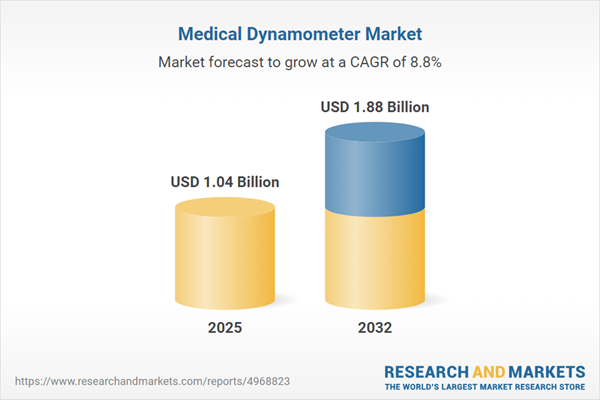Speak directly to the analyst to clarify any post sales queries you may have.
Healthcare organizations are advancing digital transformation to improve clinical efficiency and compliance, making the medical dynamometer market an increasingly vital sector for senior decision-makers seeking integrated, data-driven solutions.
Market Snapshot: Medical Dynamometer Market Size and Growth
The global medical dynamometer market demonstrates steady growth, driven by a dependable compound annual growth rate and the expanding role of these devices across hospitals, outpatient centers, and specialty care environments. The rising adoption of digital health tools continues to shape market momentum, as medical dynamometers offer crucial support within telemedicine and evolving health IT infrastructures. These devices enable objective measurement, facilitate robust clinical planning, and contribute to more coordinated operational workflows. As healthcare entities prioritize accurate, repeatable assessment and seamless technology adoption, medical dynamometers consistently deliver measurable value and enhanced compatibility with digital platforms.
Scope & Segmentation of the Medical Dynamometer Market
A precise understanding of market segments enables decision-makers to align procurement with organizational objectives, clinical needs, and compliance requirements. Medical dynamometer solutions span a wide technological and operational spectrum, supporting a range of applications and user environments.
- Technologies: Hydraulic, load cell, pneumatic, and strain gauge dynamometers address various endurance and research scenarios, ensuring reliable measurements that adapt to clinical or scientific sophistication requirements.
- Product Types: Analog dial and spring-based models provide foundational assessment capabilities, while digital handheld and tabletop options enhance electronic health record integration and streamline data flow across care teams.
- Connectivity: Options such as Ethernet and USB support wired compatibility with existing IT environments, while Bluetooth and Wi-Fi enable wireless remote monitoring for distributed or multi-site healthcare settings.
- Applications: Medical dynamometers facilitate standardized assessments and outcomes measurement within geriatrics, orthopedics, sports medicine, rehabilitation, preventive care, and research, delivering objective benchmarks for diverse clinical needs.
- End Users: Hospitals, clinics, rehabilitation centers, research laboratories, and academic institutions rely on these devices for clinical evaluations, scientific inquiry, and educational purposes.
- Distribution Channels: Direct procurement from manufacturers, collaborations with distributors, and digital commerce platforms ensure streamlined device acquisition, supporting operational consistency and procurement compliance.
- Regional Scope: Procurement dynamics and compliance obligations differ across North America, Europe, South America, Asia-Pacific, and the Middle East & Africa, making local adaptation indispensable for effective adoption and long-term value.
- Key Companies: Industry progress is led by providers such as Patterson Companies, Ametek, Hausmann Enterprises, Fabrication Enterprises, Saehan Corporation, Marsden Group, Takei Scientific Instruments, MICROTEKNIK, Shimpo Instruments, and North Coast Medical, whose advances shape the market landscape.
Key Takeaways for Senior Decision-Makers
- Adopting digital and wireless medical dynamometer options accelerates integrated clinical workflows, fostering efficient collaboration both within departments and across remote locations.
- Strategic partnerships with prominent manufacturers enhance supply reliability and support organizational resilience, especially during periods of regulatory transition.
- A balanced device portfolio—including both analog and digital models—enables healthcare organizations to meet varying clinical needs and prepare for future IT system enhancements.
- Diversified sourcing channels, such as direct manufacturer agreements, distributor collaborations, and digital procurement, elevate access flexibility and can help mitigate supply chain risk.
- Engaging experienced vendors promotes streamlined solution integration and facilitates the rollout of updated clinical assessment standards.
- Customizing procurement strategies to comply with local regulatory and reimbursement frameworks ensures optimal resource deployment throughout multiple regional markets.
Tariff Impact on the Medical Dynamometer Market
Planned United States tariffs scheduled for 2025 are expected to affect sourcing dynamics for medical dynamometers. Senior healthcare leaders should proactively review current procurement approaches, deepen engagement with domestic suppliers, and implement robust risk management strategies to maintain access to essential assessment tools despite evolving regulatory and trade conditions.
Methodology & Data Sources
This assessment synthesizes published clinical research, published trial outcomes, and cross-industry procurement perspectives from healthcare executives, delivering a comprehensive perspective on market trends and purchasing priorities.
Why This Report Matters for Medical Dynamometer Market Stakeholders
- Equips organizations with strategy guidance, benchmarking resources, and detailed insight into advancements in medical dynamometer technology for more effective patient management and operational efficiency.
- Delivers actionable analysis on regulatory shifts, product introductions, and changing distribution models to enable stronger compliance and market positioning.
- Provides senior leaders with practical insights to guide sustainable organizational growth and enable informed decision-making amid changes in the healthcare environment.
Conclusion
This analysis provides actionable recommendations to guide procurement and technology adoption strategies, empowering senior executives as they address regulatory changes and lead clinical progression in the evolving medical dynamometer market.
Additional Product Information:
- Purchase of this report includes 1 year online access with quarterly updates.
- This report can be updated on request. Please contact our Customer Experience team using the Ask a Question widget on our website.
Table of Contents
3. Executive Summary
4. Market Overview
7. Cumulative Impact of Artificial Intelligence 2025
Companies Mentioned
The companies profiled in this Medical Dynamometer market report include:- Patterson Companies, Inc.
- Ametek, Inc.
- Hausmann Enterprises, LLC
- Fabrication Enterprises, Inc.
- Saehan Corporation
- Marsden Group
- Takei Scientific Instruments Co., Ltd.
- MICROTEKNIK
- Shimpo Instruments Co., Ltd.
- North Coast Medical Inc.
Table Information
| Report Attribute | Details |
|---|---|
| No. of Pages | 189 |
| Published | October 2025 |
| Forecast Period | 2025 - 2032 |
| Estimated Market Value ( USD | $ 1.04 Billion |
| Forecasted Market Value ( USD | $ 1.88 Billion |
| Compound Annual Growth Rate | 8.7% |
| Regions Covered | Global |
| No. of Companies Mentioned | 11 |









